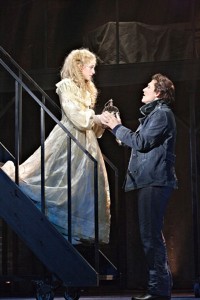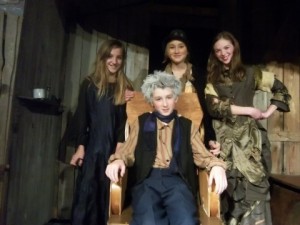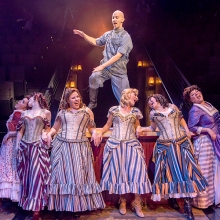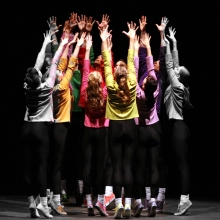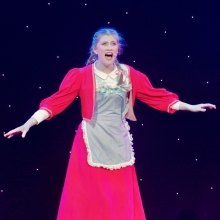Filichia Features: Ooooh, Mr. Todd!
Filichia Features: Ooooh, Mr. Todd!
Attend the tale of Benjamin Barker.
Well, that’s Sweeney Todd’s real name, isn’t it? Or so Mrs. Lovett tells us three songs into the 1978-1979 Tony-winning musical.
But if you’re considering presenting the Stephen Sondheim - Hugh Wheeler masterpiece, you’ll of course use the title Sweeney Todd. Not simply because you’re contractually obligated, but more because people are much more aware of Barker’s assumed name. Sweeney Todd’s pedigree will sell the tickets for you.
At the recent production at the Pennsylvania Shakespeare Festival, director Dennis Razze had some new ideas for a musical that’s suddenly a third-of-a-century old. Perhaps some will inspire you.
One notion might not seem new: that Razze filled the aisles with chorus members. But he did it so well and consistently during the three-hour show that he seemed to be expanding the stage to include the entire house. We actually felt as if we were sitting on the stage and sharing it with the actors.
Sweeney Todd has often been described as “Grand Guignol,” named for that theater in Paris that specialized in plays with exaggerated acting and melodramatic effects. Razze kept to that concept by starting the show with an eerie-looking man, wearing ragged clothes and a distressed top hat, peering at the audience through a large magnifying glass. Another gentleman (if we can call him that) played a few haunting notes on a concertina.
Ah, I thought, this is in lieu of that shrieking whistle. Lord knows how much of our hearing we’ve all lost over the years from enduring, as the script all-too-accurately describes it, “the deafening shrill sound.” But, no, Razze included that, too. Would it spoil some vast eternal plan if it weren’t included?
During “The Ballad of Sweeney Todd,” Razze had his actors erect a sheet which was then back-lit to show a razor-wielding Sweeney in silhouette. The back-light was extinguished, and seconds later, through some theatrical magic, the sheet was pulled to the floor and the actor we'd expected to see there had somehow vanished. If you can pull this off, it’s quite the coup de théâtre.
Soon we saw the real Sweeney: William Michals, who’s had Broadway experience as Gaston and Emile de Becque. Those are parts for dashing leading men, and one could tell from Michals’ 8x10 glossy in the lobby that he had the looks for those roles.
As Sweeney, however, Michals was made up in such a way that he could haunt a house. He rather resembled Riff-Raff from The Rocky Horror Show. The moral of the story: you aren’t required to make your Sweeney look at all like Len Cariou.
Michals flew down the aisle so quickly that his coat billowed from the breeze he created. It flared out like the cape of a superhero – a term we can’t apply to a man who routinely murders innocent victims because he’s angry with all mankind. That does make him, however, a super-anti-hero and musical theater's most dastardly. He certainly believes that two wrongs make inroads on making a right.
After a half-hour of seeing Sweeney scowl and grimace, Michals suddenly gave out with a big smile. The occasion was the arrival of the judge who framed him and stole his wife. Now he was here for a shave. Saving the smile for this moment was extraordinarily effective, for it actually seemed shocking. And how many shows can say that a smile does that?
As dynamic as Michals’ "Epiphany" was, Razze made it more dramatic by having the house lights come up soon after the song began. Thus Sweeney’s "They all deserve to die" more baldly focused on us. As Michals stared us down, we had no place to hide.
Most of us use the word "epiphany" when we've had something wonderful happen to us. Leave it to Sondheim to use it to title a song in which a man goes crazy. To be fair, the dictionary does say that “epiphany” means "a sudden, intuitive perception of or insight into the reality or essential meaning of something, usually initiated by some simple, homely, or commonplace occurrence or experience.”
Still, how often has it been used in a negative way?
Katie Wexler as Johanna, James Stapb as Anthony. Photo by Lee A. Butz.
So many stories involve love vs. career – from The Front Page to Jelly’s Last Jam – but here we have a man who waves off Mrs. Lovett’s affection not because he’s a workaholic, but because he’s intent on revenge. Here’s hoping your Sweeney has the single-mindedness of Michals.
On the other hand, you needn’t make your Mrs. Lovett resemble Helen Bonham Carter from the film, as Dee Roscioli did. She had so much white dough-dust on her face that she looked as if a blood-letting session had just drained her from ear to ear.
Razze had Roscioli play it as if she were crazy from the start. While admitting to making "The Worst Pies in London," she tossed the dough from one hand to the other in time to the music, and then, in what's-the-use frustration, hurled the entire wad against the back wall. It got a good laugh from the crowd.
Put to good use by Razze was what has become known in the trade as a “Harold Prince bridge” (although Prince didn’t use one when he directed the original Sweeney Todd). Razze had two actors move some staircases on wheels so that when a character on the upper level needed to get down to the stage, there’d be a staircase waiting for him. (By the way, these staircases provided all the “choreography” that one can expect from a Sweeney Todd.)
That bridge came in handy in the scene where Anthony and Johanna first lay eyes on each other. Razze positioned her high above the technically earthbound sailor. And while Razze kept her extreme stage left and him extreme stage right, Katie Wexler and James Stabp connected with a love-at-first-sight, bolt-of-lightning look that overcame the distance. Stabp also did wonderfully by that flattened note on the word “dream” that’s as delicious as bittersweet chocolate.
What to remember when auditioning? Have your would-be Sweeneys display their whistling prowess. Another Sondheim show insists that anyone can whistle, but that's not true – and Sweeney must whistle for a few bars before he starts singing “Pretty Women."
Also remember that your Signor Pirelli – the former Daniel O’Higgins -- must be able to employ both Italian and Irish accents that seem convincing and not parodistic. And speaking of accents, make certain that your cast members who play Cockney drop their "h's" as consistently as Eliza Doolittle did before she met 'enry 'iggins. The ones here in Pennsylvania were quite adept.
Think of how many musicals, plays, movies and television shows you’ve seen in which someone walks in at the wrong time and discovers something he shouldn’t see. It’s such an easy device for a playwright to use – which is why so many have overused it. Notice that Sondheim and Wheeler avoided that by putting a brain into Tobias’ head. He doesn’t accidentally stumble into seeing something incriminating on how Mrs. Lovett and Sweeney have been spending their time – at least not at first. He simply has a feeling that something is wrong, and finds it continually growing.
And yet, Charlie Mann was smart to have Tobias feel guilty for even suspecting Sweeney. When he suggested to Mrs. Lovett that Sweeney was up to no good, he effectively expressed his anxiety by being unable to look her in the eye. In this scene, Mann beautifully established that he wasn’t just grateful and protective of Mrs. Lovett; he genuinely loved her, too.
Of course, Tobias eventually does come across the incontrovertible evidence -- when the just-killed Beadle comes through the chute and lands in front of him. And in this production, that was the only time we saw the chute open and a body fall out.
View photos of Sweeney Todd on MTIShowSpace
The original production had Sweeney send his just-murdered victims through a trap door in his upper room; we saw them reappear seconds later as they slammed through the small door in the basement. This is obviously a complicated gambit that involves building a workable chute. Razze didn’t bother himself with it, and simply had the victims go through the trap door and didn’t have us see them again. For the scene involving The Beadle, actor Evan Harrington had enough time to pick himself up, move over to the door and thrust himself through it. So don’t feel as if you must have a workable chute.
What you must have is a workable and able cast. The vocal demands aren’t pretty: a bass-baritone is not only a must for Sweeney, but also for the Judge (Christopher Coucill certainly made his soar.)
You’ll need two sopranos, too – not just one for Johanna, but another for the Beggar Woman. She may be crazy, but she still has a beautiful voice. (Michele Sexton very much did.) Anthony has a few moments where a tenor voice is useful, but a baritone better fits the part. The Beadle, Pirelli and Tobias require tenor voices, and while you can’t hope to get three tenors as amazing as those Three Tenors Plácido Domingo, José Carreras and Luciano Pavarotti, you still will have to have able ones.
Get all these performers and a director with as much imagination as Dennis Razze. You’ll find that audiences will want to attend the tale of Sweeney Todd.

You may e-mail Peter at pfilichia@aol.com. Check out his weekly column each Tuesday at www.masterworksbroadway.com and each Friday at www.kritzerland.com. His newest book, Broadway Musical MVPs, 1960-2010: The Most Valuable Players of the Past 50 Seasons, is now available through Applause Books and at www.amazon.com.
Share
Callboard
-
Shake and shimmy it with the #Hairspray20Challenge! Join MTI and Broadway Media in celebrating 20 years of #Hairspray. Duet this here or find us on TikTok! Special thanks to @broadwaymedia and @jammyprod. Choreography Guides are a licensor official resource that provides step-by-step instruction from Broadway and professional choreographers for your productions! Visit @broadwaymedia to learn more. #mtishows #youcantstopthebeat #hairspraymusical #goodmorningbaltimore
View on Instagram

